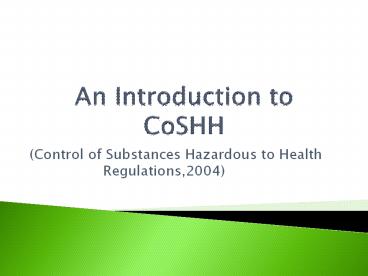An Introduction to CoSHH PowerPoint PPT Presentation
1 / 28
Title: An Introduction to CoSHH
1
An Introduction to CoSHH
- (Control of Substances Hazardous to Health
Regulations,2004)
2
What is a hazardous substance under the
Regulations?
- Substances mixtures classified as dangerous
under CHIP (Chemicals (Hazard Information and
Packaging for Supply) Regulations 2008 ) - Substances with WELs (Workplace exposure limits)
- Biological agents
- Some dusts, especially in high concentrations
- Other substances of comparable hazard
3
What are NOT hazardous substances under CoSHH?
- Lead and Asbestos (separate regulations)
- Substances only hazardous due to
- Radio-activity
- Simple asphyxiants
- High pressure or extremes of temperature
- Biological agents not connected with work
- Eg Swine flu or catching a cold from a colleague
- Labels are a good guide!
4
What must an employer do?
- Eliminate or reduce risks from hazardous
substances - This is achieved by
- Risk assessment
- Control measures
- Monitoring health exposure if necessary
- Information, training and supervision
5
What must an employee do?
- Take reasonable care of our own safety and not
endanger others - Cooperate with our employer
- Make full and proper use of control measure
- Just reiterating our duties under HSAW
6
Step 1 Risk Assessment for CoSHH
- Identify the hazardous substance(s) eg
- Chemicals
- Biological materials
- Mixtures
- Proprietary products
- Reaction products and intermediates
7
Step 1 Risk Assessment for CoSHH
- New International Hazard Symbols
- Danger Flammable Oxidiser
8
Step 1 Risk Assessment for CoSHH
- New International Hazard Symbols
- Explosive Corrosive Compressed or
- liquefied gas
9
Step 1 Risk Assessment for CoSHH
- New International Hazard Symbols
- Aquatic Warning Sensitiser, carcinogen,
- Toxicity mutagen or teratogen
10
OTHER SYMBOLS YOU MIGHT SEE WHAT DO THEY MEAN?
11
FLAMMABLE
EXPLOSIVE
HARMFUL TO THE ENVIRONMENT
HIGHLY FLAMMABLE
TOXIC
IRRITANT / HARMFUL
CORROSIVE
VERY TOXIC
OXIDISING
BIOLOGICAL AGENT
12
Step 1Other sources of information
- Use available data eg.
- Data sheets labels
- Workplace exposure limits (WELs) see Safety
Services web site - On-line databases
- Previous experience publications
- (Especially for novel products)
13
Step 1Decide who is at risk and how
- Staff
- Students
- Others
- Consider their current training (if any) and
their background
14
Step 1Decide who is at risk and how
- Inhalation
- Skin or eye contamination
- Ingestion
- Injection
15
Step 1Evaluate the Risk
- Factors to Consider
- Toxicity
- Form (gas, spray, dust, liquid, solid)
- Solubility
- Amount (weight /or volume)
- Nature of the operation
- Length of exposure
- Number of people involved
OR
16
Step 2 Decide on Control Measures
- Control exposure in proportion to risk by using
the hierarchy of controls. - Personal protective equipment should be a last
resort as the prime means of control
?
17
Step 3 Use of Control Measures (1)
- Replace substance with a safer alternative
- Eg use a lower hazard disinfectant rather than
bleach (irritant) if it will do the job adequately
18
Step 3 Use of Control Measures (2)
- Use the material in a safer form eg
- Use water-based paint instead of solvent-based
paint - Buy hazardous materials in pre-weighed sachets
rather than having to measure make-up from bulk
quantities
19
Step 3 Use of Control Measures (3)
- Control the operation eg
- Isolate the work
- Control at source
- Fume cupboard
- Local exhaust ventilation
- Reduce the number of workers
- Reduce the frequency
20
Step 3 Use of Control Measures (4)
- Personal protective equipment as a last resort
- Protects only the worker not others in the room
- Training maintenance required
- Often not very comfortable
21
Step 3 Use of Control Measures (5)
- Good laboratory techniques is vital eg.
- Labelling
- Correct substance storage
- Warning signs where appropriate
- Cleanliness tidiness
- Correct waste disposal
22
Step 4 Maintenance of control measures
- Must be kept in good repair working properly
- Regular simple checks on airflow
- LEV fume cupboards must have engineering checks
every 14 months - Records kept for 5 years
23
Step 5Monitor Exposure
- Measure concentrations where assessment concludes
that - There is a serious risk if controls fail
- Exposure limits may be exceeded
- Control measures may not be working properly
- Employees are involved in certain specific work
in Schedule 5 (unlikely in the University apart
from possibly use of vinyl chloride monomer) - Records must be kept for 5 years
24
Step 6Health Surveillance
- Only required if
- Significant exposure of Schedule 6 processes
(apart from vinyl chloride use, these are all
manufacturing processes) - Likelihood of exposure to substances linked to
specific diseases but only if - There is a reasonable likelihood that this will
occur - It is actually possible to detect the disease or
effect - Records to be kept for 40 years
25
Step 7 Derive safe working procedures
- Preparation phase(eg weighing out)
- The process itself
- Safe waste disposal
- Emergency procedures
- Spillage
- Fire
- First aid
26
Step 8Workers must have adequate
- Information
- Instruction
- Training
- Supervision
- This will include the procedures themselves and
what to do in an emergency
27
Step 9Check and review
- Are the control measures adequate?
- Are they working correctly?
- Is everyone aware of how to use them?
- Have you the necessary equipment to deal with an
emergency or malfunction?
28
What now?
- If you are working in a Science, Medicine or
Engineering department, you should now find out
the specific forms and methods used in your
department for CoSHH assessments. - If you are working mainly with proprietary
products (cleaning materials, lubricants,
household chemicals etc), you may find it useful
to complete the presentation on examining data
sheets

